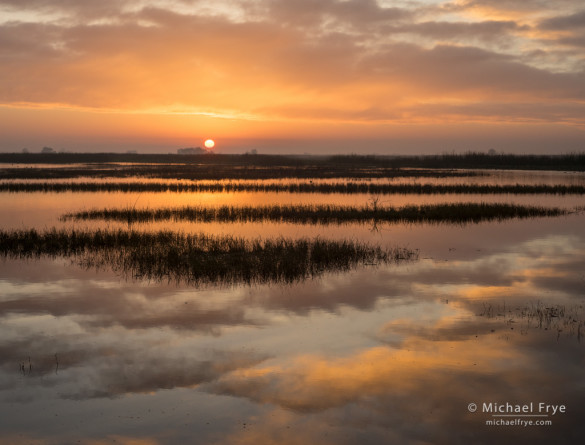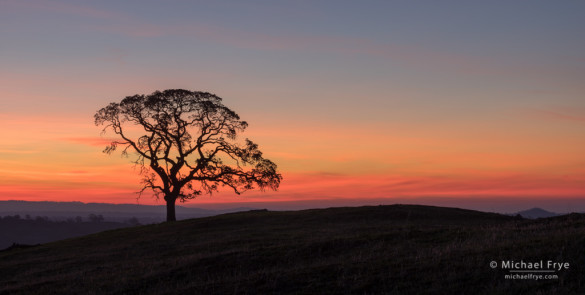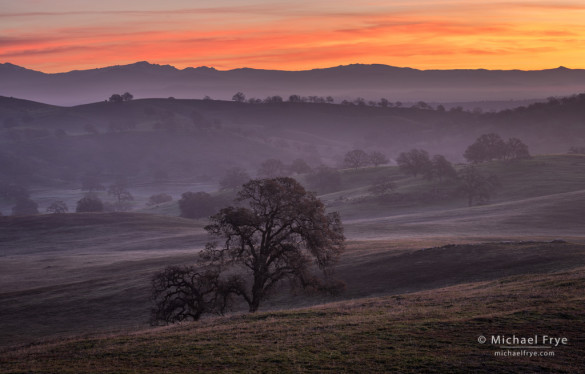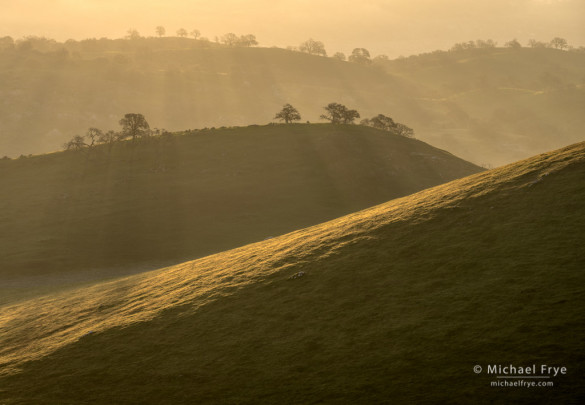I’m grateful to live near Yosemite Valley, one of the world’s most spectacular landscapes. But in photography, light is more important than subject. My most popular image of 2014 featured an orchard in the Sacramento Valley – with exceptional light. I’d rather photograph an “ordinary” scene in great light than an extraordinary scene in dull light.
Last month Claudia and made an early-morning drive to one of the wildlife refuges in the flat-as-a-table-top expanse of the San Joaquin Valley. I was hoping for fog, which is common on winter mornings in the Central Valley. Instead, I found the beautiful clouds and reflections shown in the photograph above. In this case, the flat landscape helped, making it possible to catch the orange ball of the sun just as it crested the horizon. The light, clouds, colors, and reflections helped to convey a nice early-day mood.
A few days ago I got up early and drove to a spot in the lower Sierra foothills, on the edge of the Central Valley. This area won’t ever become a national park, but the rolling, grass-covered hills and scattered oaks have their own beauty. I knew the moon would be setting around sunrise, and hoped some Central-Valley fog might creep up into the hills, so I could photograph the moon setting over the fog bank. But no such luck. The fog didn’t make it up that far, and some clouds to the west blocked the moon.
There was, however, a touch of ephemeral mist in the atmosphere, helping to create a sense of depth and distance in views of the layered hills. And a bank of clouds to the east turned orange and red as the sun came up, adding color. I looked for compositions that included interesting trees, or some of the layered hills, as well as the color in the sky or the mist. While my original plan didn’t work, the light turned out to be just as interesting in a different way. (You’ll find three photographs from that morning below.)
In both places, I tried to find compositions that highlighted the characteristic features of the landscape. In the foothills, that meant showcasing the scattered oaks and rolling hills. In the marsh, I used the water, reflections, and patterns of reeds. Partly this was just working with the most interesting things I could find, but I also wanted to convey a sense of place – to give the viewer the feeling of standing in a specific, unique landscape at a wonderful moment.
Most people can’t live near Yosemite or the Grand Canyon. But everyone lives near someplace beautiful, someplace that can be highly photogenic under the right conditions. If you get to know that place well, you’ll know what conditions to look for, and where to go when the light gets interesting. Perhaps more importantly, you’ll gain an appreciation for the unique beauty of that area, and how you can convey that beauty in your photographs.
— Michael Frye
Related Posts: My Top Photographs of 2014; A Trip Through the Central Valley
Did you like this article? Click here to subscribe to this blog and get every new post delivered right to your inbox!
Michael Frye is a professional photographer specializing in landscapes and nature. He is the author or principal photographer of The Photographer’s Guide to Yosemite, Yosemite Meditations, Yosemite Meditations for Women, Yosemite Meditations for Adventurers, and Digital Landscape Photography: In the Footsteps of Ansel Adams and the Great Masters. He has also written three eBooks: Light & Land: Landscapes in the Digital Darkroom, Exposure for Outdoor Photography, and Landscapes in Lightroom 5: The Essential Step-by-Step Guide. Michael has written numerous magazine articles on the art and technique of photography, and his images have been published in over thirty countries around the world. Michael has lived either in or near Yosemite National Park since 1983, currently residing just outside the park in Mariposa, California.













Michael,
Ordinary? I think not. There is beauty in the simplicity of these landscapes but it takes the touch of an artist to capture it in a manner that conveys it to others. As usual, you have succeeded in doing just that.
Well ordinary in the sense that most people, and most photographers, wouldn’t think that these places were particularly special, or go out of their way to visit them. Anyway, thanks!
Michael,
Thank you for such a down-to-earth post. Yes, there is beauty all around us, and I appreciate your encouraging us to find that beauty on our doorsteps.
You’re welcome Wei, and thanks!
Great insight, Michael, as usual! When I first started shooting landscape 2 years ago, I thought all I need to do is to show up & shoot, & get whatever photos I had in mind. Then I found out having a back-up shot in mind is ALWAYS a good idea.. as what we need for a good photo is completely up to what mother nature decides to give us. Sometimes, the unexpected back-up shot turns out to be the shot of the day….. & thats exciting!
Its becoming easier & easier nowadays to shoot nice photos, but its the experiences & insights from people like you that are most valuable. Learning to ‘SEE’, is the hard part.
Please keep sharing with us…. thank you!
BTW, hows the Firefall looking? Seems like we r in a dry pattern again 🙁 Hopefully it will rain soon!
Thanks Andy. Yes, it’s always good to be flexible!
There’s no water in Horsetail Fall. To have any hope of a decent Horsetail Fall season we need some higher-elevation snow over the next month.
I find your photos most inspiring and well done.
Can you tell me how or what program you you use to put your name or logo on your
Photo.I have a Mac Computer. Thanks
Cyndi Bane
Thanks Cyndi! I use Lightroom and Photoshop to add the watermark. Lightroom has a watermarking feature which lets you create a text watermark, or choose a graphic watermark that you’ve created elsewhere. I used Photoshop to create the graphic, and then choose that graphic in Lightroom when I export an image.
So beautiful. You’ve really captured the sense of those places and shown their beauty. Something about the last one captures me the most. Thank you for sharing your work, thoughts and process!
Thanks so much Joolz!
gorgeous light and beautiful compositions. Thanks for the advice
Thank you Felicia, and you’re welcome!
Hi Michael,
I think you will love this. This sweeping bird’s-eye view of a portion of the Andromeda galaxy (M31) is the sharpest image ever taken of our galactic next-door neighbor.
https://www.youtube.com/watch?v=WFuyLc4aywI
That’s great Sharon – thanks!
Bravo a vous
Merci Pierre!